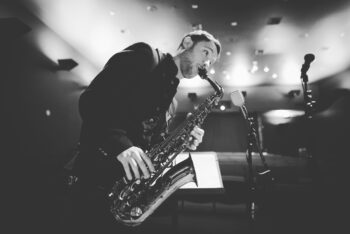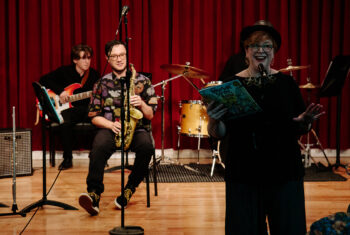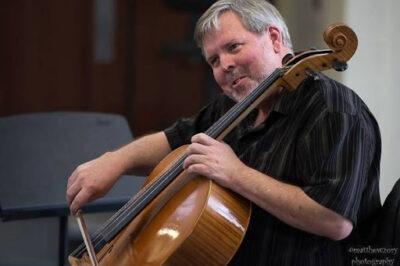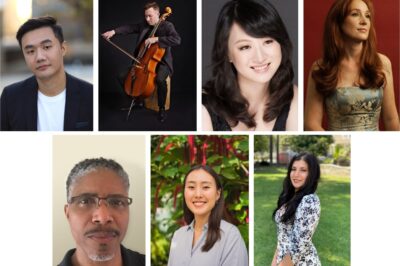Danny Janklow
April is Jazz Appreciation Month, celebrating the heritage and history of Jazz. In the following post, PCM sits down with Jazz faculty member Danny Janklow to talk about inspiration, his mentors and his role as a mentor, jazz as a living art form, and more.

What initially drew you to jazz and to learn saxophone?
It was mostly hearing saxophone on the radio. I would often hear smooth jazz on 94.7, and I loved the sound. When I got to middle school, I initially wanted to learn the trumpet, but once I tried playing the saxophone it was really “love at first honk.” I loved the feeling of the reed vibrating and being able to express myself through my breath. Before getting into music, I had done lots of karate, getting my first black belt when I was ten. A lot of my discipline and love for learning came from martial arts, and that really helped me appreciate learning jazz, music, saxophone, and the overall culture of the music I play.
How have your teachers/mentors influenced your playing and your approach to teaching?
My mentors were very honest. Some may look at it as brutally honest at times, but in a good, positive way, because they believed in me and wanted me to put my best self forward – not only as an artist but also as a leader. My high school band director John Mosley and mentors such as Dan Higgins saw that I was looking to be versatile, and they encouraged me to broaden my horizons and learn everything from classical music on my instruments to the rich history of jazz greats and their accomplishments.
As far as being a leader, they encouraged me to take myself seriously but also to hold everyone accountable when rehearsing an ensemble and coaching sectionals. This extended into college studying with Dick Oatts at Temple University and being able to start performing more and more alongside incredibly famous and talented musicians on the East Coast. They encouraged me to explore my own voice, and from that I began to compose and publish music under my own name.
As an active performer, what do you enjoy most about performing jazz live? How does this differ from your extensive studio work?
Live performance is really an irreplaceable experience for the listener and the performer. You know, through the pandemic, I feel like we all really missed out on that experience. Now that we’re getting back into it, we have a new way of feeling how that void was a really deep one, especially for the performer. There is an energy within the conversation in jazz music, which I prefer to call “Black American Music” because it was innovated and informed by the experience of Black Americans, which is unmatched in a live setting. There is a certain focus and spirituality that comes to performers when they have to work together live to raise the vibration in a room, especially one that is full of people looking to experience something magical. When I’m in the studio, that same experience needs to be synthesized—but it’s a little less organic. In a recording setting, oftentimes you’re not even in the same room, and so the tangible energy of a live performance is just not there.
Improvisation and artistic expression are cornerstones of jazz. How do you personally approach improvisation, and how do you encourage students to develop their improvisational skills and express their unique musical voices?
I think the only way to really develop these skills is to just learn lots of composers—Thelonious Monk, Duke Ellington, John Coltrane, Herbie Hancock, Charlie Parker, etc. The more you learn, the more that music becomes a part of your identity as an artist. I encourage students to stay curious about all kinds of art and music, as they can inform students to produce more thoughtful improvisations and compositions.
Improvisation and artistic expression are cornerstones of jazz. How do you personally approach improvisation, and how do you encourage students to develop their improvisational skills and express their unique musical voices?
I think the only way to really develop these skills is to just learn lots of composers—Thelonious Monk, Duke Ellington, John Coltrane, Herbie Hancock, Charlie Parker, etc. The more you learn, the more that music becomes a part of your identity as an artist. I encourage students to stay curious about all kinds of art and music, as they can inform students to produce more thoughtful improvisations and compositions.
You have collaborated with many notable artists throughout the years. Can you share some of your most memorable collaborative experiences and how they have influenced you?
The biggest thing that I have learned is to stay grounded, stay humble, and stay kind. It’s something that I have continued to learn as I collaborate with all kinds of musicians. The most memorable experiences are always the ones where the artists are the kindest, where it is not about ego but simply about the music. In 2019, both my grandparents were very sick and my grandma was in the hospital. A week before I got this call to play at the Hollywood Bowl with Terrace Martin, my grandmother unfortunately passed, and the chance to share the stage with artists who I had grown up listening to records of was really surreal. After the performance, we had a little performers’ meeting and there were all sorts of legends there: Quincy Jones, Benny Golson, Johnny Mandel. To sit there in the presence of these legendary musicians really reminded me that time is really precious and that your legacy is really what you make of it was beautiful to witness and made me feel extremely blessed for the time I had with my grandparents.
How has teaching young, aspiring jazz musicians influenced your own performances and artistry?
I really can’t remember a time when I wasn’t teaching, since I started teaching martial arts when I was so young. It’s been a part of the fabric of my existence for over 20 years, and in a way, teaching has become something like breathing. I love to mentor, to help, especially with people who are hungry for it and are inspired to learn. It gives me tremendous energy to teach someone who is curious because I can connect and relate with them, and I always encourage both my students and myself to explore as much as possible.




